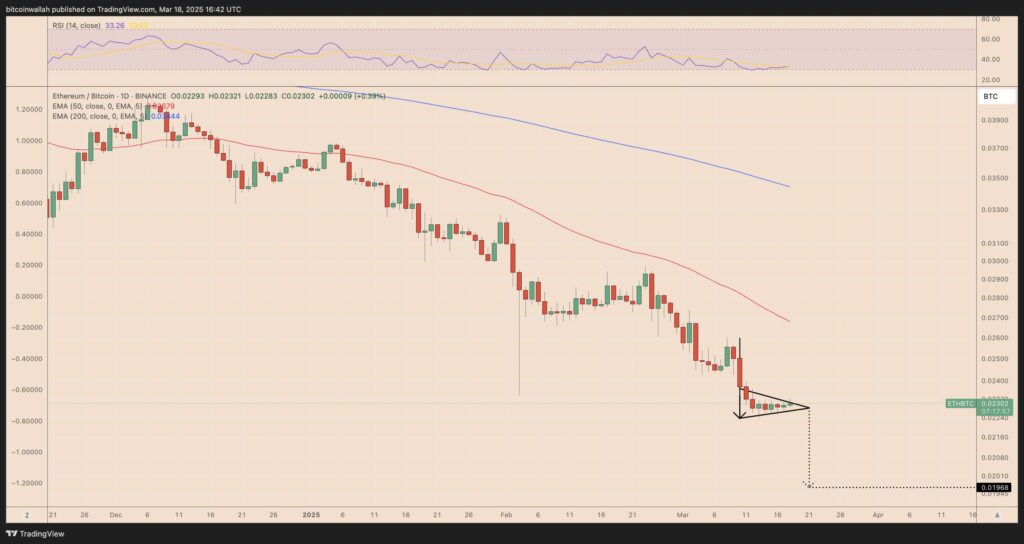In the ever-evolving world of cryptocurrency, Ethereum’s native token, Ether (ETH), finds itself in a challenging position as it frequently dips into oversold territory against Bitcoin (BTC). Despite these fluctuations, Ether has not yet managed to establish a firm price bottom, raising concerns about its market trajectory as we move further into 2024.
Recent trading patterns reveal a striking similarity to past scenarios, where ETH’s market structure hints at potential repeat breakdowns. Currently, the relative strength index (RSI) for ETH on a three-day timeframe remains below 30, traditionally signaling a possible bounce. However, historical trends suggest that each previous instance of oversold conditions has led to continued declines rather than a recovery.
“Despite the second rally of ETH price into 2024 year end, activity on mainnet as measured by gas consumption never fully recovered,” noted data analytics platform Nansen.
Recent data highlights a concerning trend for the ETH/BTC trading pair, which has experienced a string of breakdowns resulting in significant percentage losses. Observers note that negative momentum persists, evident from the downward trajectory of the 50-day and 200-day exponential moving averages (EMAs). This has led to skepticism about Ether’s bullish potential, especially in contrast to Bitcoin, which is seeing more robust trading activity.
June could hold further challenges for Ether, with predictions pointing to a potential 15% decline for the ETH/BTC pair based on current technical indicators. Market analysts are cautious, suggesting a bear pennant pattern could lead to a further drop unless ETH finds the strength to break through resistance levels.
“The lack of demand for ETH relative to Bitcoin is clearly underscored through recent trading volume data,” stated analysts from Glassnode.
As Ethereum’s gas fees—an essential aspect of its blockchain activity—remain significantly lower compared to last year, it indicates a shift in user engagement, with many opting for other platforms like Solana or layer 2 solutions. The evolving dynamics in the crypto market continue to unfold, leaving investors and enthusiasts closely watching how this scenario plays out against the backdrop of broader market trends.
Ethereum’s Struggles Against Bitcoin: Key Insights
Ethereum’s native token, Ether (ETH), has been facing significant challenges in the market lately, particularly in its performance against Bitcoin (BTC). Here are the crucial points to consider:
- Oversold Conditions:
- The relative strength index (RSI) for ETH is consistently below 30, suggesting potential bounce-offs.
- Historical data indicates that previous oversold conditions have not resulted in a definitive price bottom, leading to further declines.
- Frequent Breakdown Patterns:
- The ETH/BTC pair has seen repeated breakdowns with significant percentage losses (13%, 21%, 25%, and 19.5%) since mid-2024.
- 50-day and 200-day moving averages are trending downward, indicating a lack of bullish momentum.
- Negative Price Performance:
- Expert analysis suggests that the ETH/BTC pair has not confirmed any bullish divergence on the weekly chart.
- ETF Outflows and Onchain Data:
- US-based spot ETH ETFs saw 9.8% outflows in March, indicating reduced investor confidence compared to Bitcoin, which had only a 2.35% decline.
- Ethereum’s gas fees have decreased significantly, reflecting reduced network activity and potential lower demand for ETH relative to BTC.
- Future Volume Concerns:
- Bitcoin futures volume has substantially rebounded, while ETH’s trading volume remains mostly stagnant.
- This lack of demand raises concerns about Ethereum’s competitiveness in the crypto market.
- Potential Further Declines:
- The ETH/BTC pair is forming a bear pennant pattern that could lead to a 15% drop if certain trendlines are breached.
- A bullish reversal could only happen if ETH/BTC breaks above critical resistance levels.
This information serves as a critical reminder for investors to stay informed and cautious about market trends and their implications for investment strategies.
Ethereum’s Struggles Compared to Bitcoin: An In-Depth Analysis
In the landscape of cryptocurrency trading, the competition between Ethereum (ETH) and Bitcoin (BTC) has always been fierce. ETH recently faced significant challenges, showcasing a stark decline against BTC, which has been harsher than many in the market anticipated. The persistent oversold signals for Ether, particularly noted by the relative strength index (RSI) remaining below 30, reflect a troubling trend. This contrasts sharply with Bitcoin’s resilience, which continues to command stronger market interest, leading to favorable trading volumes that Ethereum simply cannot match.
One glaring competitive advantage for Bitcoin is its robust demand and liquidity, evidenced by a notable rebounding futures volume. With Bitcoin futures surging by 32% and reaching considerable heights, it presents a stark contrast to Ethereum’s stagnation. For investors and traders, this demonstrates Bitcoin’s relentless appeal as a store of value, overshadowing ETH’s struggles with lower trading activity and declining demand. Therefore, traders looking for stability and potential returns may find Bitcoin more attractive, potentially sidelining those who might have previously favored Ether.
On the other hand, Ethereum’s current market sentiment presents an opportunity for more risk-tolerant investors. While ETH grapples with a bearish outlook, the potential for future recovery remains. For those willing to ride out the volatility, a reversal in ETH’s market position could yield significant gains, especially if it successfully breaks through key resistance levels. In contrast, conservative traders might see this as a glaring disadvantage, as the likelihood of a further 15% drop in the ETH/BTC pair looms large, represented by analysis of the bear pennant pattern.
The market dynamics also hint at a trickle-down effect on ancillary projects within the Ethereum ecosystem. As outflows from spot ETH ETFs continue to worry investors—down nearly 10% while Bitcoin ETFs show strong inflows—it suggests a possible contraction in development and interest in Ethereum-based projects. This could pose challenges for altcoins relying on Ethereum’s infrastructure, particularly in a market that is increasingly drawn to alternatives like Solana and Layer 2 solutions. Developers might be incentivized to pivot their focus, leaving Ethereum and its ecosystem hanging in uncertainty. Consequently, while some investors may seize the chance to accumulate Ether at a lower price, a lack of liquidity and interest could create extended downtrends that affect all players involved.
Ultimately, the current situation not only highlights the competitive advantage Bitcoin holds over Ethereum in terms of market liquidity and investment confidence but also illustrates the complex layers of risk involved. While bullish market movement for Bitcoin may seem like the skimming cream atop the crypto landscape, market participants and investors must navigate thoughtfully through the tumultuous waters of Ethereum’s challenges. As Ethereum attempts to carve a path forward, the decisions made now will be pivotal for its future positioning against its main competitor.

















